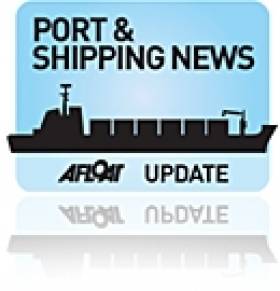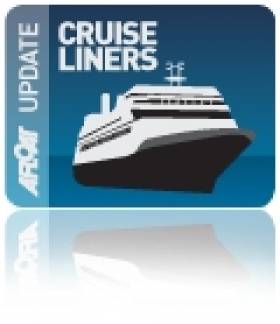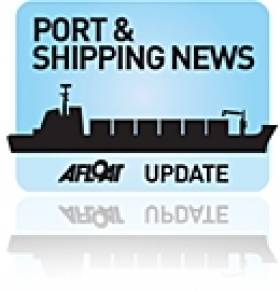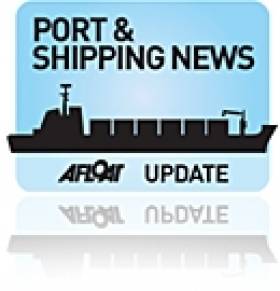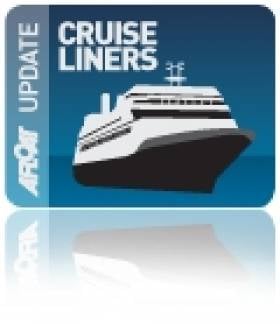Displaying items by tag: Port of Waterford
#UnderwaterWaterford – Following our port snapshot of Waterford Harbour shipping this morning which included a dredger, INFOMAR takes us on a 3D-fly-through of the estuary (in reverse direction) showing the seabed as its winds its way upriver to the city, writes Jehan Ashmore.
The 3D imagery shows (click link, scroll down and enlarge video) the varying depths and channel widths of the shipping lane along Waterford estuary taken from the research vessel, the RV Keary.
As mentioned above this is where a dredging campaign is currently underway, notably for ships using Belview Por, the main terminal facility of the Port of Waterford Company which has contracted WD Mersey (1983/1,696grt) to carry out the work.
Since late last month dredging operations along the estuary has involved the spoil to be dumped south-west off Hook Head.
As for the role of RV Keary this took place in 2011 and was the first INFOMAR survey leg to be carried out by the South African built aluminium constructed catamaran. The survey took two-months to complete and was conducted in preparation to hosting the second Tall Ships Festival held that year.
The seabed survey mapping of RV Keary concentrated on the navigational channel while the surrounding shallower waters were tasked to a smaller RIB based craft, RV Geo. Together this was the first occasion the pair of GSI vessels worked on a survey.
The 15m RV Keary is a state-run marine research survey vessel commissioned for and operated by the Geological Survey of Ireland (GSI). As reported in 2012, the Central Fisheries Board cutter Cosantoir Bradan was chartered by GSI in an RV role.
The vessels primary function is to provide an inshore survey capability for the national INtegrated Mapping FOr the Sustainable Development of Ireland's MArine Resource - in short INFOMAR.
In addition assistance in the INFOMAR programme which is funded by the Department of Communications, Energy and Natural Resources, is also made available from the Marine Institute's pair of research vessels, RV Celtic Voyager and larger fleetmate RV Celtic Explorer.
To keep track of GSI vessels current locations, click this map-link.
Cruiseships Visits to Bring Variety to Waterford Estuary
#WaterfordCrystalCruises – Opening the Port of Waterford's cruise season next Monday is Noble Caledonia's Island Sky, the 118 passenger and 77-crew vessel is to dock along the city's quays, writes Jehan Ashmore.
Island Sky is the first of 17 cruise callers to the 'Crystal' city among them Crystal Cruises six-star rated Crystal Symphony (940 passenger/545 crew) which calls in August and Crystal Serenity (1080/655) to form the final cruise call of the season in early September.
Island Sky will also be the first cruise caller to make a repeat call in June out of the 12 cruiseships visiting, among them the largest Celebrity Infinity (see pictured under cruise-schedule list link). The 3,000 plus passenger vessel and more than 1,200 crew on board are to anchor off Dunmore East and like last year she is to return this season in June and August respectively.
Also due to make an impressive sight off Dunmore East in July and September, is Wind Surf, the 310-guest vessel, which as the name suggests sets seven triangular self-furling sails than are operated by computers. The former Club Med I currently operated by Windstar Cruises has a sail surface area of 26,881sq ft set on five 164-ft masts.
The third location in Waterford Estuary for cruise callers is the port's main terminal at Belview Port which as previously reported on Afloat.ie is connected with an inter-model operation with freight-train services linking in with regular containership calls.
However in August, the cruise season's only caller to dock along Belview is to be Regent Seven Sea Cruises Seven Seas Voyager, another six-star rated vessel with capacity for 700 guests and pampered by almost 500 crew.
#SeaRailFreight- A year has passed since Afloat.ie reported on the revival of container rail-freight services between Waterford Port and Ballina, to link in with DFDS Logistics sailing schedules to Europe.
According to multimodal.org.uk which has more on this, since the re-launch in early March last year of the DFDS Logistics liner trains between Ballina rail freight terminal and Belview Port at the Waterford of Port (onward shipping to Rotterdam) the service has moved over 2,500 containers.
The service, operating twice weekly in both directions, departure from Ballina at 11:05 on Tuesdays and Fridays and from Port of Waterford at 11:30 on Mondays and Thursdays.
#HollandAmerica – Dunmore East is to host three Holland America Line (HAL) cruiseships of varying sizes this season which runs until mid-September, writes Jehan Ashmore.
The largest of the trio Eurodam (86,273grt) had visited today with an anchorage call and she is to be followed by a pair of fleetmates next month. The twin funnelled vessel is cruising from Alesund in Norway to Amsterdam with a passenger capacity potential of 2,104 passengers and a crew of 929.
Next to call on 2 August is Veendam (56,982grt) also from Amsterdam and heading for Bergin with her 1,350 passenger capacity and 580 crew. She is named after the capital of the Netherlands's northern peat colonies.
Making the final member of this trio is a call on 14 August by Prinsendam (37,845grt), which is the smallest of HAL's 15-strong cruiseship fleet.
She originally began her career as Royal Viking Line's white hulled Royal Viking Sun, and she is to sail from Reykjavik to Amsterdam with her designed capacity of 766 passengers and 460 crew.
Combined these calls bring a welcome boost to the Waterford estuary region with benefits to key tourist attractions, among them the House of Waterford Crystal.
Across the estuary is the Hook Lighthouse & Heritage Centre which as previously reported is where the Gathering of Lighthouse Keepers is to be held on the Hook Peninsula in September.
#CruiseLiners – Sea Explorer, the small cruiseship which underwent a period of 'lay-up' in Dun Laoghaire Harbour as previously reported on Afloat.ie, is currently berthed in Barrow-in-Furness, having departed the Irish port last month, writes Jehan Ashmore.
Owned by Miami based International Shipping Partners (ISP), the 4,200 tonnes cruiseship with a 118 passenger capacity remained in Dun Laoghaire Harbour for just over a fortnight.
It was envisaged that the former Corinthian II which was renamed in Cadiz prior to her repositioning voyage to Dun Laoghaire Harbour, would at least remain in port until June before starting on a new cruise charter career.
Despite the relocation of Irish Sea port, Sea Explorer is currently in lay-up mode in the Cumbrian port, however she is due to start a new career during the summer on charter to Copenhagen based Albatross Travel. The Danish operator will be running cruises in Greenland. For several winter seasons, she will run for Polar Latitude on cruises in the Antarctic.
Also reported on Afloat.ie was the Waterford cruiseship season which started this month. Among the callers will be Sea Explorer which is due on 21 May and is to berth along the city-quays.
The call is to follow cruiseships that will have either taken anchorage or berthed at various locations throughout Waterford estuary.
Waterford Cruise Season to Blossom in May
#Cruiseliners – Waterford Estuary is to welcome more than 20 cruise calls in 2013 with the first caller being Island Sky in early May, writes Jehan Ashmore.
The small 118 passenger cruiseship operated by Noble Caledonia and with a crew of 77 will make a brief anchorage call off Dunmore East.
During the afternoon visit, passengers are to visit the Mount Congreve Gardens, a spectacular woodland garden upriver on the banks of the River Suir.
Among the other callers that month are the 110 passenger Serenissima, a former Norwegian vessel that served on the Hurtigruten coastal service and also as the Andrea running cruises to polar-regions. She is to dock alongside Waterford's city-centre quays.
The third location on the estuary where cruiseships call is Belview, downriver of the city facing Waterford Island. The container terminal facility which is the primary port for Waterford is where the 408 passenger Hamburg is due to berth. For a list of all liners calling this season click HERE.
#SeaRailFreight- A new container rail-freight service between Waterford Port and Ballina began operating this week, to link in with DFDS Logistics sailing schedules to and from Europe.
The container trains are running to a twice weekly service in each direction linking the Belview Port terminal downriver of Waterford City and the northern Co. Mayo town.
According to Irish Rail (Iarnród Éireann), the new service will benefit customers in the west and north-west of Ireland in particular, providing them with a cost effective alternative when compared with a road based shipping. Coupled with this, the customer also reduces their carbon footprint.
The trains are scheduled to meet DFDS lo-lo vessels sailing from Belview Port to Rotterdam, which allows for onward delivery into Europe. Customers can now load in the west of Ireland on Tuesday morning and deliver in The Netherlands on Thursday pm/Friday am.
Rotterdam also provides access to DFDS sailings to Norway, and rail connections to Italy, allowing for a rail-sea-rail connection from Ballina to Milan.
DFDS will utilise a significant amount of available rail-wagons, but have left scope to develop the service further by introducing new customers, both internal Irish traffic and import / export traffic.
This is an important addition to the DFDS services in Ireland, and as a customer for Irish Rail's freight division. The new service is covering a longer distance, guaranteed volumes and direct port access.
The introduction of the service will see freight volumes increase from 91m tonne kilometres in 2012 to 105 m tonne kilometres approximately in 2013.
Cattle Ship for Libya Under Different Name and Bound for Misrata
#CATTLE-SHIP -It transpires the livestock-carrier which departed Waterford port just over a week ago is under a different name and is bound for Misrata, and not the Libyan capital Tripoli as reported, writes Jehan Ashmore.
The livestock-carrier's previous name was Al Mahmoud Express (1983/7,087grt) but is now the Express 1, which has revived the live cattle trade, not seen since 1996, when Libya banned beef imports from the EU, following the outbreak of (BSE) mad cow disease.
The Panamanian flagged vessel with 2,900 cattle, is in the Mediterranean Sea between Tunisia and Malta and the passage time from Ireland to Libya is estimated to take up to 10 days.
During the vessels near 48 hour call to Belview, the port of Waterford, animal welfare groups had expressed concerns of the resumption in the trade carried out at the downriver terminal in which they tried to access.
The vessel is no stranger to Irish waters having operated as the custom built vehicle-carrier Autoline.
Livestock-Carrier to Restore Trade with Libya
#LivestocktoLibya – A livestock-carrier docked in Waterford Port yesterday, to restore the trade with Libya, which banned beef imports, following the BSE (mad cow) disease which broke out in Ireland, more than 17 years ago, writes Jehan Ashmore.
Al Mahmoud Express is believed to be operated by a Syrian shipping company. The 7,089 tonnes vessel berthed at Belview, the port's main terminal facility, downriver of the city on the Waterford Estuary. It was back in the 1990's, when the city quays last saw live-stock trading on a more regular basis.
Together the Department of Agriculture and the IFA have been working strenuously to have live cattle exported to North Africa.
IFA Livestock Director Kevin Kinsella said that cattle agents are now buying cattle for live export and are looking for coloured cattle, and continental breeds, Angus and Hereford. Mr Kinsella expressed the hope that the live trade will also resume shortly to Egypt and Lebanon.
Prior to the Panamanian flagged vessel setting sail to Ireland, officials from the Department of Agriculture carried out an inspection of the ship in Turkey, which led to some modifications.
In this first shipment to Libya, up to 2,900 live cattle are to be transported to Tripoli. It is estimated the passage time will take 10 days, with an en-route call to Ceuta, the Spanish enclave which neighbours Morocco.
The cattle kill is likely to be up by up to 150,000 this year, and with this additional outlet will help to keep upward pressure on prices.
Al Mahmoud Express, was previously a 700 capacity vehicle-carrier that regularly called to Irish ports. As the Autoline, the 1983 built vessel ran for United European Car Carriers (U.E.C.C.) and up to several years ago she included calling to Rosslare, before been sold.
Polar Expedition Cruiseship Heads Waterford Cruise Caller List
#CRUISE CALLS – Waterford is to welcome its first cruise caller in 2012 with the Quest (1992/1,180grt) an ice-strengthened expedition cruiseship which is to dock next month along the city-quays, writes Jehan Ashmore.
Normally she operates around the Scottish Isles, Norway, Greenland and Spitsbergen. This year she will make her itineraries for the first time around Ireland, England and Wales.
The stout looking Danish built vessel is just 50m in length, has a beam of 11m and draws 3.5m, this allows her to reach more destinations in difficult conditions. She carries around 50 passengers and a crew half that number. For images including interiors and deck plans click HERE
Quest is also scheduled to make a second call to the south-east city in May. Following both these calls another 17 cruise callers are lined up for the season which runs until September.
Among the callers are the 940 passenger capacity Crystal Symphony, the 66,000 tonnes Marina which only entered service last year, Ocean Princess (for a dry-dock slideshow click HERE) and the 1988 built Prinsendam.
Depending on the vessel's draught, the location of where they will call in Waterford estuary will vary. Aside the city quays, the other berth is in Belview and for deep drafted vessels, they take anchorage off Dunmore East. To view the full cruise call list click HERE.





























